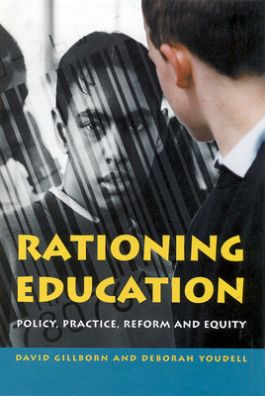RATIONING EDUCATION
1st Edition
0335203604
·
9780335203604
© 1999 | Published: December 16, 1999
"This research should make us extremely sceptical that the constant search for 'higher standards' and for ever-increasing achievement scores can do much more than put in place seemingly neutral devices for restratification." - Michael W Apple, John B…
Read More
Request Review Copy
Receive via shipping:
- Colour, print bound version of the complete text
Education and equity
Reforming education
policy and practice
Ability and economy
'intelligence' and the A-to-C economy
Selection 11 to 14
fast groups, 'left over' mixed ability and the options
Selection 14 to 16
setting, tiering, hidden ceilings and floors
Educational triage and the D-to-C conversion
suitable cases for treatment?
Pupil perspectives
Conclusions
rationing education
Notes
References
Index.
Reforming education
policy and practice
Ability and economy
'intelligence' and the A-to-C economy
Selection 11 to 14
fast groups, 'left over' mixed ability and the options
Selection 14 to 16
setting, tiering, hidden ceilings and floors
Educational triage and the D-to-C conversion
suitable cases for treatment?
Pupil perspectives
Conclusions
rationing education
Notes
References
Index.
"This research should make us extremely sceptical that the constant search for 'higher standards' and for ever-increasing achievement scores can do much more than put in place seemingly neutral devices for restratification." - Michael W Apple, John Bascom Professor of Curriculum and Instruction and Educational Policy Studies, University of Wisconsin, Madison
Recent educational reforms have raised standards of achievement but have also resulted in growing inequalities based on 'race' and social class. School-by-school 'league tables' play a central role in the reforms. These have created an A-to-C economy where schools and teachers are judged on the proportion of students attaining five or more grades at levels A-to-C. To satisfy these demands schools are embracing new and ever more selective attempts to identify 'ability'. Their assumptions and practices embody a new IQism: a simple , narrow and regressive ideology of intelligence that labels working class and minority students as likely failures and justifies rationing provision to support those (often white, middle class boys) already marked for success.
This book reports detailed research in two secondary schools showing the real costs of reform in terms of the pressures on teachers and the rationing of educational opportunity. It will be important reading for any teacher, researcher or policymaker with an interest in equality in education.
Recent educational reforms have raised standards of achievement but have also resulted in growing inequalities based on 'race' and social class. School-by-school 'league tables' play a central role in the reforms. These have created an A-to-C economy where schools and teachers are judged on the proportion of students attaining five or more grades at levels A-to-C. To satisfy these demands schools are embracing new and ever more selective attempts to identify 'ability'. Their assumptions and practices embody a new IQism: a simple , narrow and regressive ideology of intelligence that labels working class and minority students as likely failures and justifies rationing provision to support those (often white, middle class boys) already marked for success.
This book reports detailed research in two secondary schools showing the real costs of reform in terms of the pressures on teachers and the rationing of educational opportunity. It will be important reading for any teacher, researcher or policymaker with an interest in equality in education.

